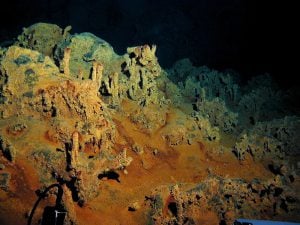Illustration of Zuul Crurivastator, new species of ankylosaur. (Illustration courtesy of Danielle Dufault, Royal Ontario Museum)
The tail of these armoured ankylosaurs comprises half the body and has a large club at the end of it. Despite their menacing appearance, ankylosaurs were plant-eaters, using their armour and clubbed tail to fend off predators. They were so well shielded they even had armoured eyelids.
Zuul was found with both its head and its tail – and several other parts that have yet to be worked out of a 15-tonne rock – which makes it the most complete ankylosaur skeleton found to date. It was preserved in such good condition that both of its armoured eyelids were found, along with its soft tissue and skin.
“This skeleton is totally exquisite,” says Evans who has been leading dinosaur digs in the badlands of southern Alberta for over a decade. “It must have been buried when the skin was still in place.”
Zuul was found by accident in the summer of 2014 in northern Montana, just 50 kilometres south of Alberta where Evans does his research. A private collector was digging up a tyrannosaur skeleton when a bulldozer hit the clubbed tail of Zuul’s skeleton. Because the skeleton was 10 metres into the hillside and ensconced in rock, it hadn’t been exposed to erosion. If no one had bulldozed into it, it likely wouldn’t have been discovered for thousands of years. “Here’s an example where human activity has benefited science,” says Evans.
Unlike other species of ankylosaur, Zuul has ornamentation in the armour between its eyes and on its snout. It also has swept horns above its eyes and on the cheeks, which was in large part what gave its resemblance to the monster from the movie.
When researchers noted the resemblance to the monster, they floated the name Zuul past Dan Aykroyd who starred in the original Ghostbusters film and is a big supporter of Canadian palaeontology. According to Evans, armoured dinosaurs are a favourite of Aykroyd, and he was happy to use the name on this new species.
“This is a real terror dog in the form of an ankylosaur,” says Aykroyd in a video with the Royal Ontario Museum. “We’re so honoured that the Royal Ontario Museum would accord the name of this magnificent creature with the appellation that we called our terror dog in the movie.”
The pristine preservation of Zuul’s skeleton means there is still much more to learn from it. “We’re hoping this leads to a discovery of some of the original biomolecules,” says Evans, which would help develop knowledge of the biology of ankylosaurs.





